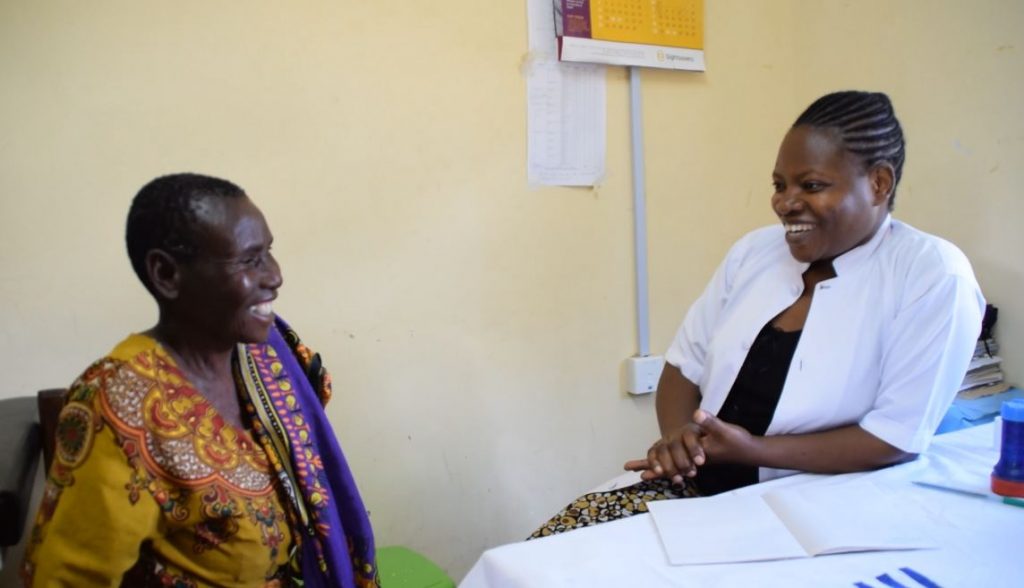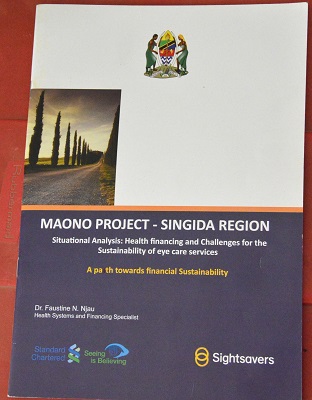Join a powerful, unprecedented alliance for better eye health for all.
Join IAPB-
Choose an alternate language here

Sightsavers’ Maono Project has been working with the Singida Regional Authority since April 2016 to support and strengthen the regional referral hospital and district health facilities to increase demand for eye care and enable eye health treatment to be brought closer to the communities.
Since the inception of the project, the number of people who received cataract surgery per year has increased from 530 in 2015 to 2,600 in 2018. Moreover, the number of districts offering eye care services has increased from one in 2015 to four by June 2019.
The advocacy component of the project aimed to influence the Government of Tanzania (through the regional health management team) to increase their commitment to eye health services across all seven districts of Singida region. While we have seen a significant increase in the budget allocation for eye health, the amount allocated is still insufficient to meet the current eye care demands in the region. The government allocated 37,916 USD for consumables and surgical outreaches in Singida’s 2018/2019 regional plan, compared with 104,022.56 USD allocated through the SiB project. It is with this background that the project supported the development of an Eye Health Financing Mechanism to enable the regional authority to increase their revenue through cost recovery from eye care service delivery across the seven districts.
 Eye Health Financing Mechanism
Eye Health Financing MechanismIn 2017, with support of a consultant, the project explored financing options that would provide a practical financing framework with the ultimate goal of increasing access to sustainable quality eye care services funded from a domestic source with the intention of minimizing dependence on donor funding while ensuring the continuity of services (currently funded by donors). Click here to read the full report.
Singida Regional Authority, through the Regional Health Management Team (RHMT) and seven Council Health Management Teams (CHMTs), were involved in the design of the Singida region eye care financing mechanism. Key stakeholders such as the National Health Insurance Fund (NHIF) and the Ministry of Health Community Development Gender Elderly and Children were consulted to share their experiences and learning during the design of the financing framework.
The NHIF is an alternative financing option in the Tanzanian health sector, which is a result of the Government of Tanzania’s decision to implement health sector reforms. The aim of the Fund is to bring quality health services closer to its members and support medical providers. The Fund currently caters for government employees, including their spouses and up to four children and/or legal dependents (i.e. up to six people in a family).
The improved Community Health Fund (iCHF) was launched in November 2014 with the aim of increasing access to quality healthcare for people in the informal sector, mostly rural and low-income groups. It is a voluntary, public-private health insurance scheme, built on a strong partnership between the NHIF, the district councils (local government), public and private healthcare facilities and PharmAccess. It offers an extensive benefits package, covering primary care and referral for inpatient care for up to five-days of admission. The premium is currently set at 30,000/= Tanzania shillings (less than USD 14) per household per year.
The project explored the opportunities available within the NHIF to identify possible areas where Singida Regional Authority can ensure a more sustained way of financing eye care in the region. The following opportunities were identified:
NHIF pays 350,000/= Tanzania shillings (equivalent to 152.2 USD) for each eye surgery at the regional referral hospital and 150,000/= Tzs (65.2 USD) when surgeries are done at the district hospital or other lower level facilities. For refractive error, NHIF pay 2.2 USD for all patients to have their visual acuity tested and 8.7 USD for reading glasses (for principle members only).
Sightsavers’ eye health financing mechanism calls for the recovery of eye care costs, through utilisation of NHIF and iCHF and the use of dedicated bank accounts for eye care in all districts (and at the regional referral hospital). It also calls for the sensitisation of the community to encourage individuals to pay for health insurance, where possible. Following the dissemination of the eye health financing mechanism, the key achievements are:
District and Regional Level Advocacy: The project team continue to conduct advocacy meetings with community leaders to generate buy in towards self-sustainability through the eye health financing mechanism. This advocacy focuses on:
National Level Advocacy: Sightsavers Tanzania ensured that lessons learned from the implementation of the eye health financing mechanism are integrated into the newly launched National Eye Care Strategic Plan 2018/2022. On page 15, the Ministry of Health calls for the integration of eye health in national insurance schemes (iCHF and NHIF), and the introduction of the cost recovery model.
The eye health financing mechanism requires integration with health insurance schemes however; some eye care services are not covered by NHIF/iCHF.
The eye health financing mechanism calls for Sightsavers, the Ministry of Health Community Development Gender Elderly and Children and the Singida Regional Authority to ensure the sustainability of project outcomes, however it requires separate financial resources for effective follow up and periodic training to eye care staffs and health management teams. Therefore, it is critical that future interventions invest resources into the implementation of sustainable eye health financing mechanisms.
Name: Edwin Maleko
Job title: Project Coordinator – Sightsavers
Email. [email protected]
[1] Each district will continue to operate an exemption practice whereby people who are unable to pay are offered free eye care services